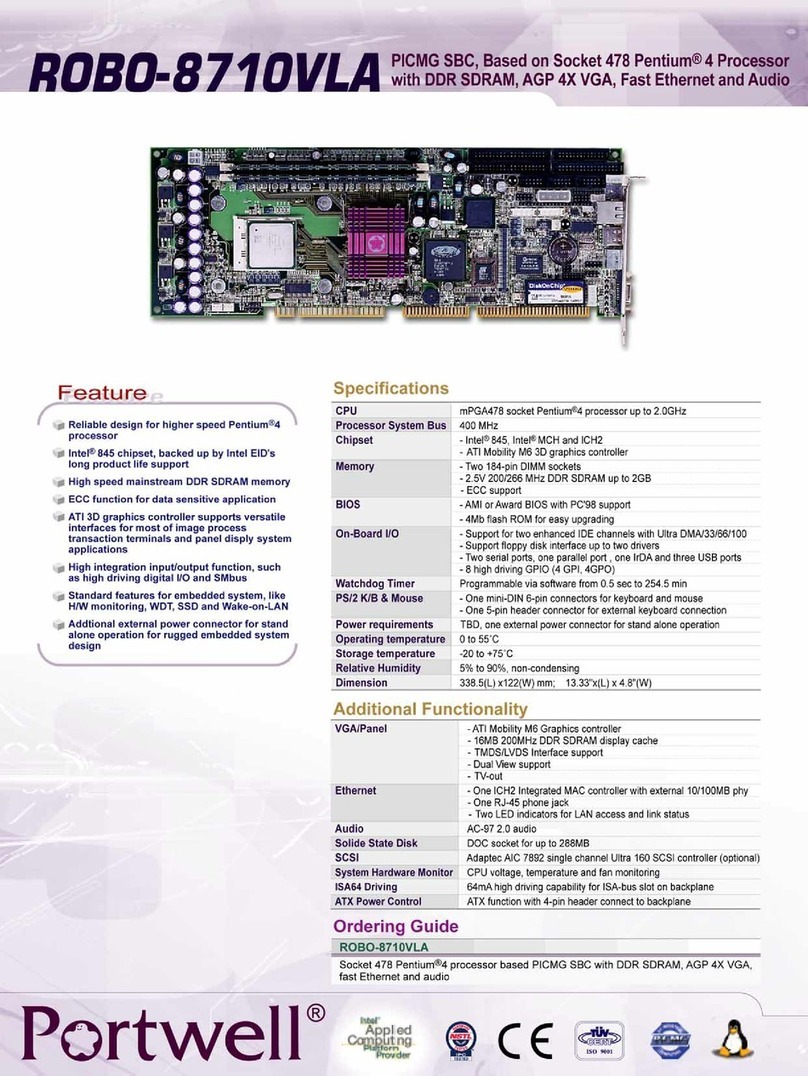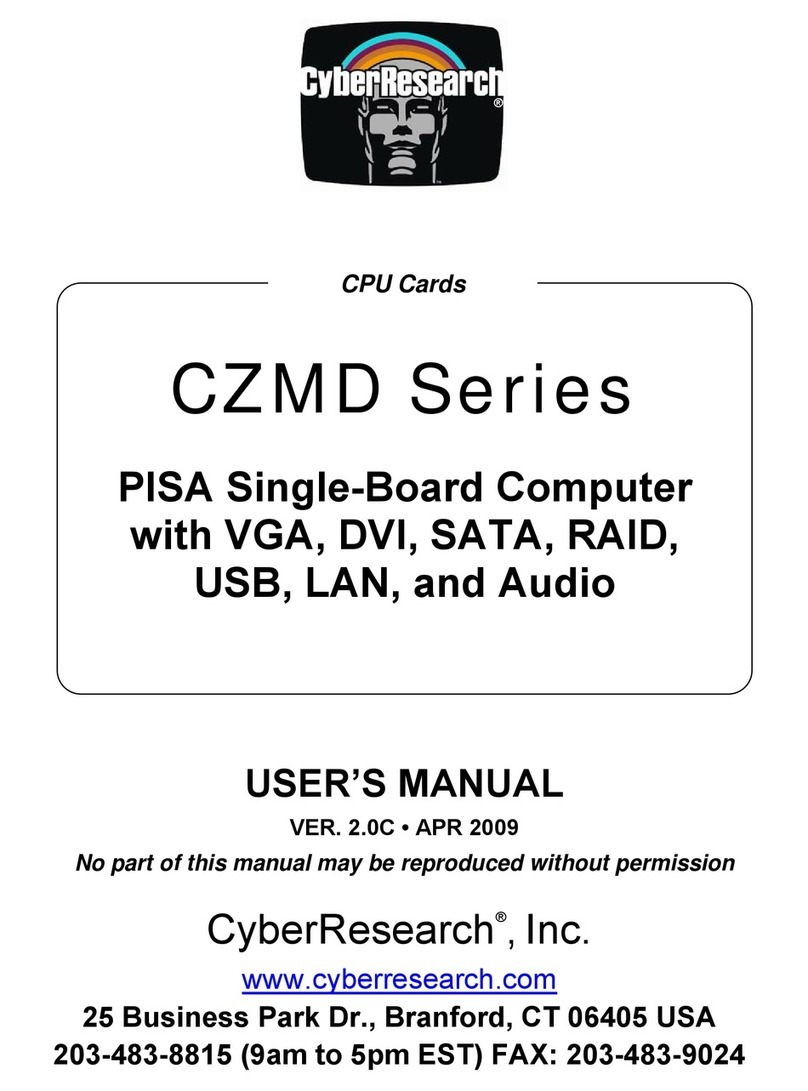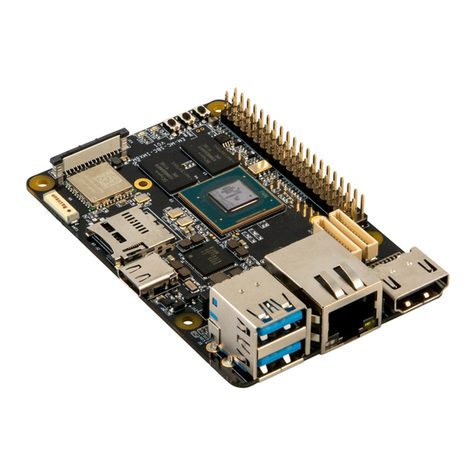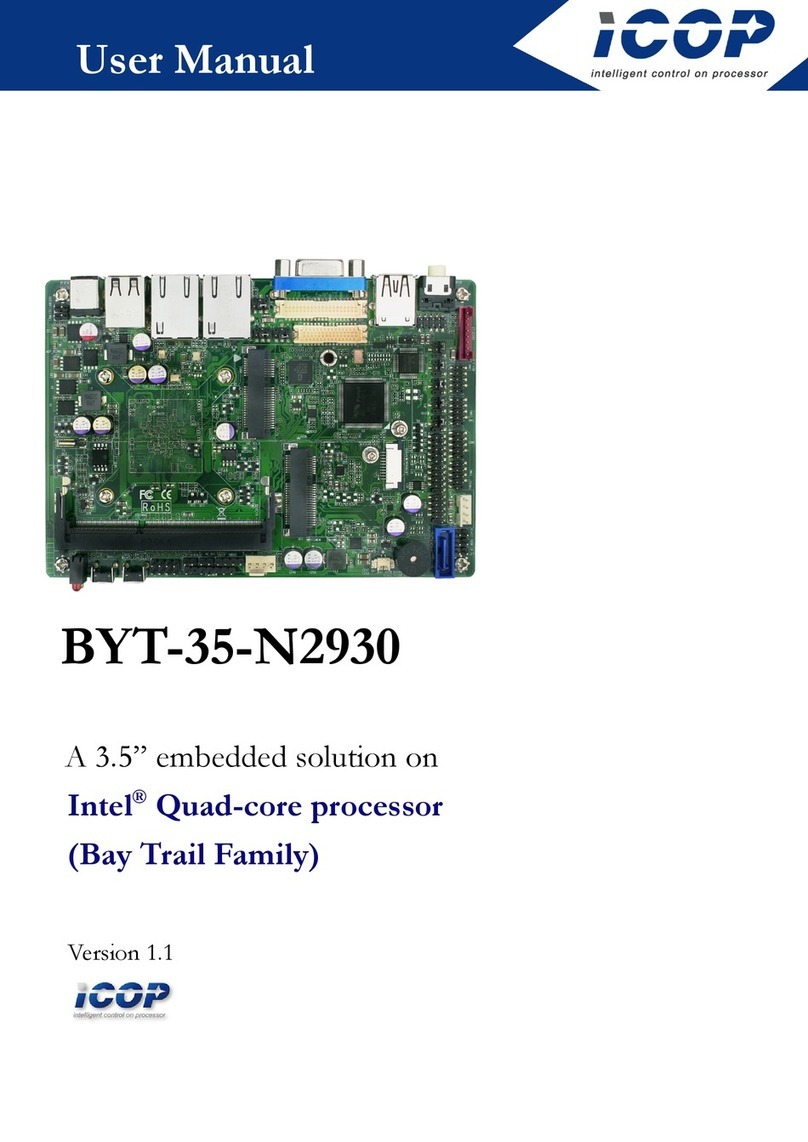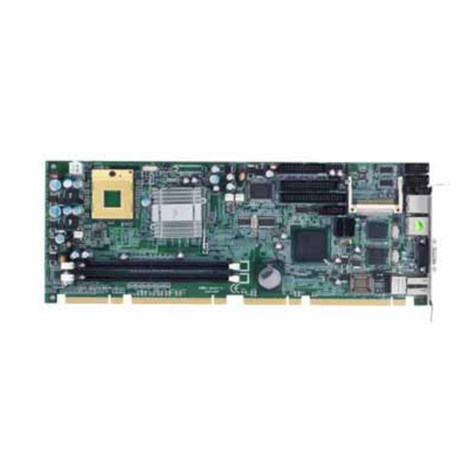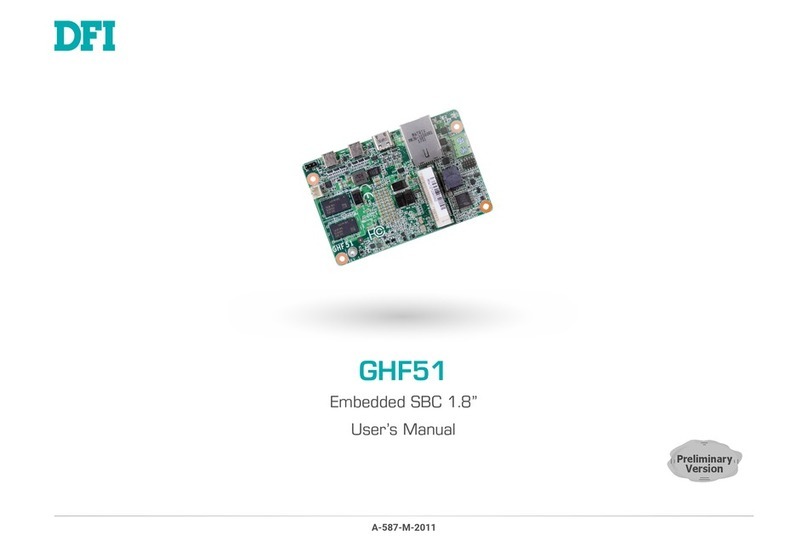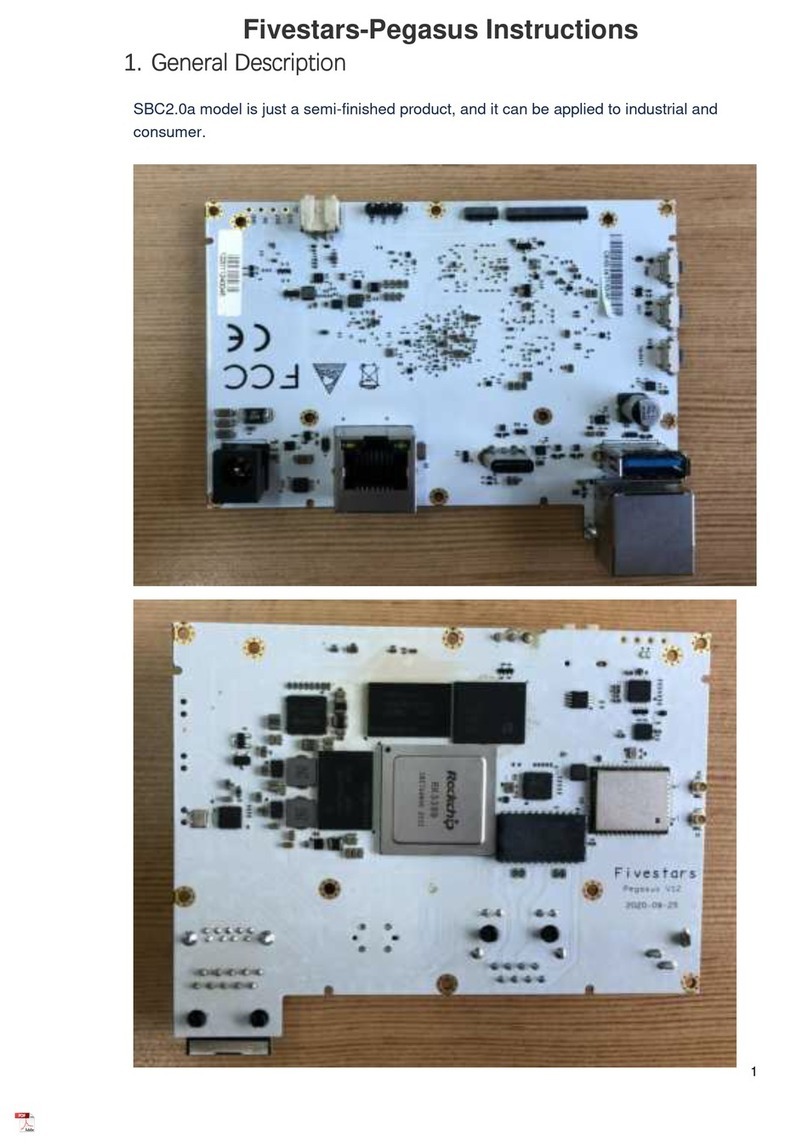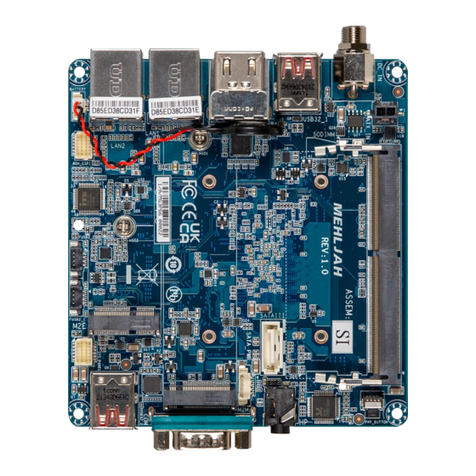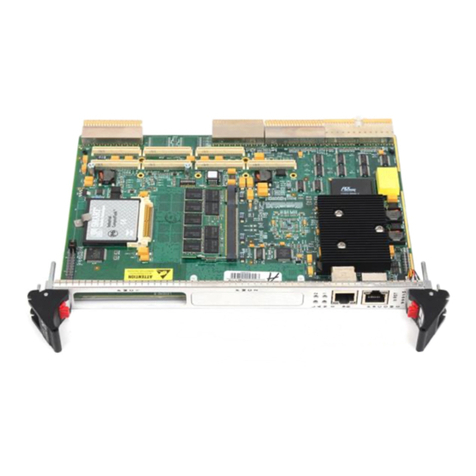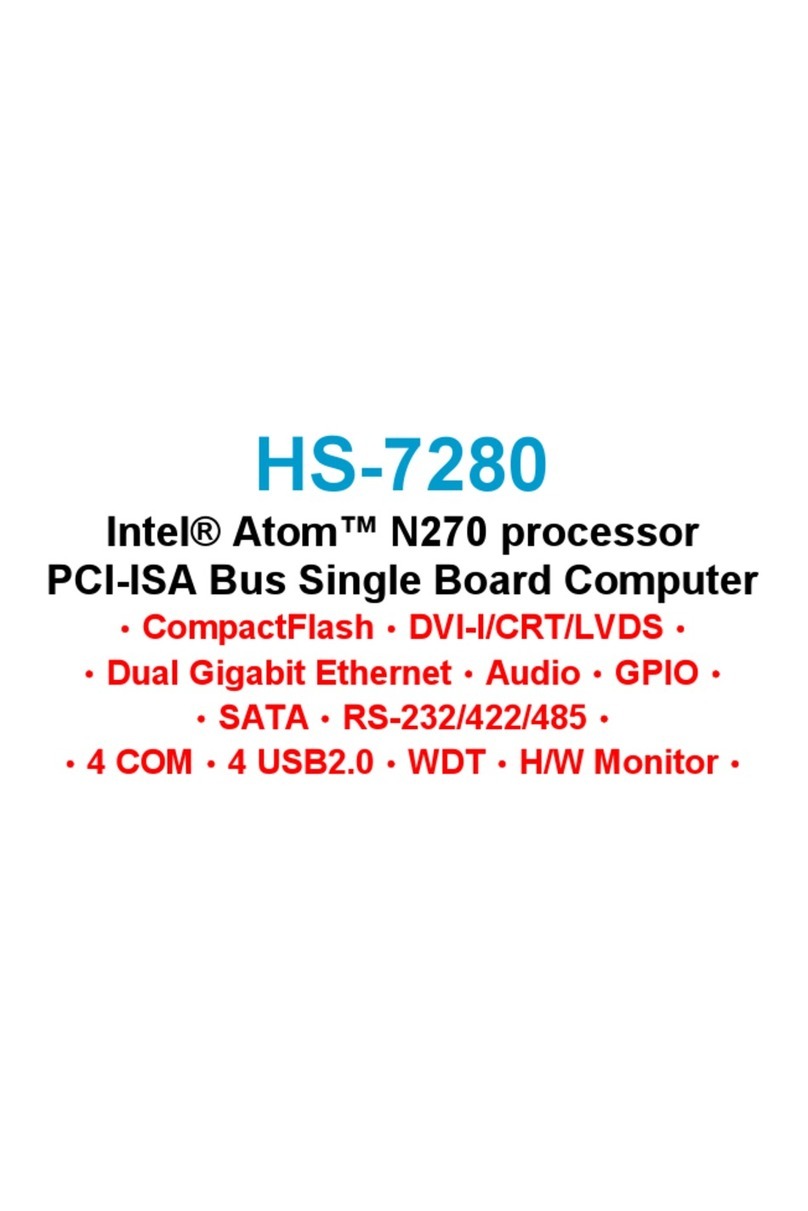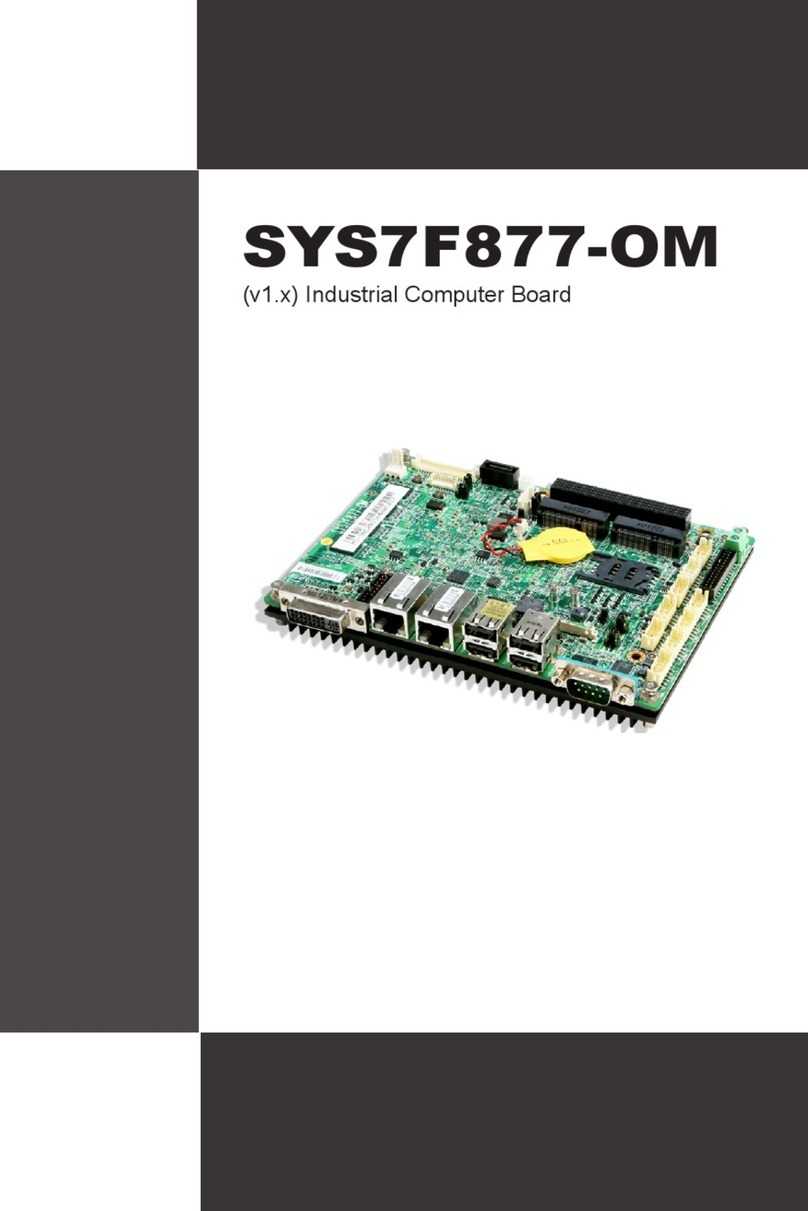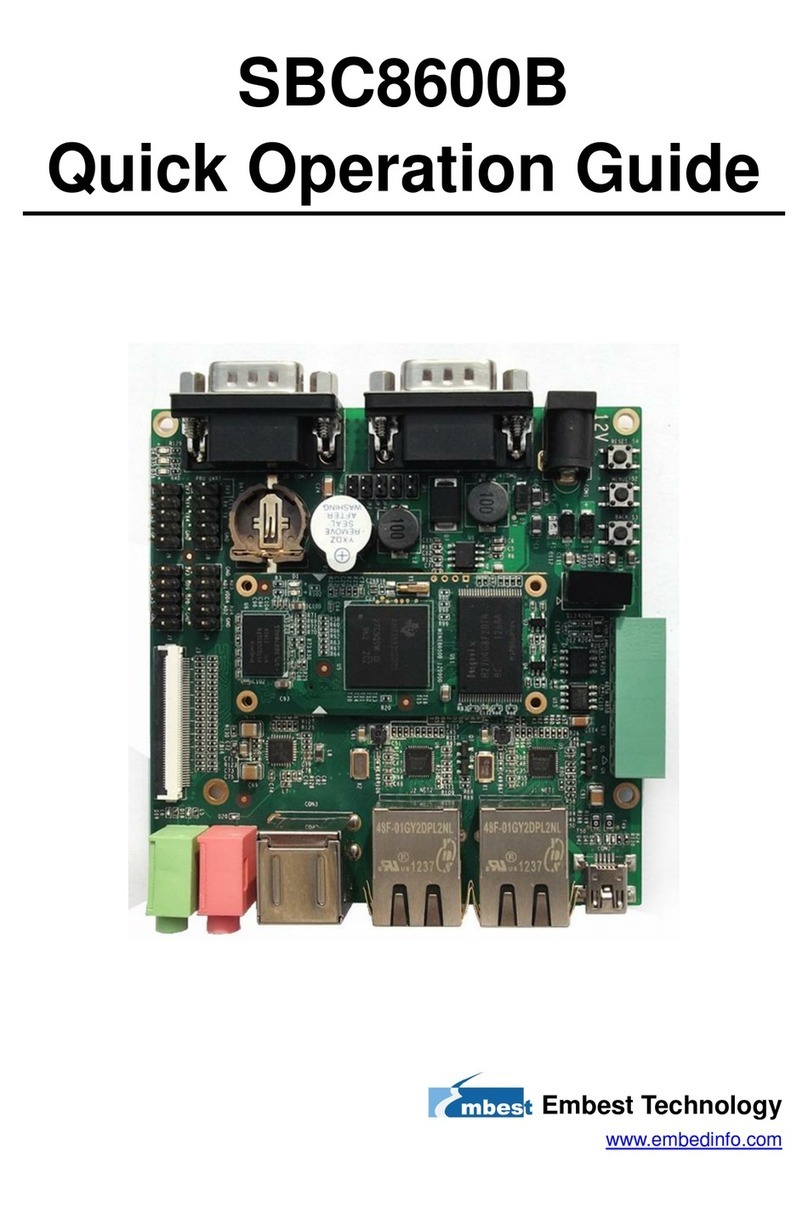SiFive E300 User manual

SiFive E300 Platform Reference Manual
Version 1.0.1
c
SiFive, Inc.

2SiFive E300 Platform Reference Manual, Version 1.0.1

SiFive E300 Platform Reference Manual
Proprietary Notice
Copyright c
2016, SiFive Inc. All rights reserved.
Information in this document is provided “as is”, with all faults.
SiFive expressly disclaims all warranties, representations and conditions of any kind, whether ex-
press or implied, including, but not limited to, the implied warranties or conditions of merchantabil-
ity, fitness for a particular purpose and non-infringement.
SiFive does not assume any liability rising out of the application or use of any product or circuit, and
specifically disclaims any and all liability, including without limitation indirect, incidental, special,
exemplary, or consequential damages.
SiFive reserves the right to make changes without further notice to any products herein.
Release Information
Version Date Changes
1.0.1 Dec 19, 2016 Minor clarifications on PWM, SPI, AON register fields
1.0 November 29, 2016 Initial release for HiFive1 release.
i

ii SiFive E300 Platform Reference Manual, Version 1.0.1

Contents
SiFive E300 Platform Reference Manual i
1 Introduction 1
1.1 BlockDiagram .......................................... 1
1.2 Configurable E31 RISC-V Coreplex . . . . . . . . . . . . . . . . . . . . . . . . . . . . . . 1
1.3 CustomAccelerators....................................... 2
1.4 On-ChipMemory......................................... 2
1.5 Execute-in-Place Quad-SPI Flash controller . . . . . . . . . . . . . . . . . . . . . . . . . . 2
1.6 PeripheralDevices........................................ 3
1.7 Platform-Level Interrupt Controller . . . . . . . . . . . . . . . . . . . . . . . . . . . . . . . 3
1.8 Always-On Block and Power Management . . . . . . . . . . . . . . . . . . . . . . . . . . . 3
1.9 DebugSupport.......................................... 3
1.10 SoftwareTools .......................................... 3
2 E300 Platform Memory Map 5
3 E300 Power Modes 7
3.1 RunMode............................................. 7
3.2 WaitMode ............................................ 7
3.3 SleepMode............................................ 7
4 E300 Clock Generation 9
4.1 ClockGenerationOverview................................... 9
4.2 Internal Trimmable Programmable 72 MHz Oscillator (HFROSC) . . . . . . . . . . . . . . 9
4.3 External 16 MHz Crystal Oscillator (HFXOSC) . . . . . . . . . . . . . . . . . . . . . . . . 11
4.4 Internal High-Frequency PLL (HFPLL) . . . . . . . . . . . . . . . . . . . . . . . . . . . . . 11
4.5 PLLOutputDivider........................................ 13
4.6 Internal Low-Frequency Oscillator (LFRCOSC) . . . . . . . . . . . . . . . . . . . . . . . . 13
4.7 External 32.768 kHz Low-Frequency Crystal Oscillator (LFXOSC) . . . . . . . . . . . . . 13
iii

iv SiFive E300 Platform Reference Manual, Version 1.0.1
5 E300 Always-On (AON) Domain 15
5.1 AONPowerSource ....................................... 15
5.2 AON Clocking and Tilelink Slave Port . . . . . . . . . . . . . . . . . . . . . . . . . . . . . 15
5.3 AONResetUnit ......................................... 15
5.3.1 Power-OnResetCircuit ............................... 16
5.3.2 ExternalResetCircuit ................................ 16
5.3.3 ResetCause ..................................... 17
5.4 WatchdogTimer(WDT)..................................... 17
5.5 Real-TimeClock(RTC) ..................................... 17
5.6 BackupRegisters ........................................ 17
5.7 Power-Management Unit (PMU) . . . . . . . . . . . . . . . . . . . . . . . . . . . . . . . . 17
5.8 AONMemoryMap........................................ 17
6 E300 Power-Management Unit (PMU) 19
6.1 PMUOverview.......................................... 19
6.2 PMU Key Register (pmukey)................................... 19
6.3 PMUProgram .......................................... 19
6.4 Initiate Sleep Sequence Register (pmusleep) ......................... 20
6.5 WakeupSignalConditioning .................................. 21
6.6 PMU Interrupt Enables (pmuie) and Wakeup Cause (pmucause)............... 21
6.7 MemoryMap........................................... 22
7 E300 Power, Reset, Clock, Interrupt (PRCI) Control and Status Registers 23
7.1 PRCIAddressSpaceUsage .................................. 23
8 E300 Watchdog Timer (WDT) 25
8.1 Watchdog Count Register (wdogcount)............................. 25
8.2 WatchdogClockSelection.................................... 26
8.3 Watchdog Configuration Register wdogcfg ........................... 26
8.4 Watchdog Compare Register (wdogcmp) ............................ 27
8.5 Watchdog Key Register (wdogkey) ............................... 27
8.6 Watchdog Feed Address (wdogfeed).............................. 27
8.7 WatchdogConfiguration..................................... 27
8.8 WatchdogResets ........................................ 27
8.9 Watchdog Interrupts (wdogcmpip)................................ 28
9 E300 Real-Time Clock (RTC) 29
9.1 RTC Count Registers rtchi/rtclo ............................... 29

Copyright c
2016, SiFive Inc. All rights reserved. v
9.2 RTC Configuration Register rtccfg .............................. 29
9.3 RTC Compare Register rtccmp ................................. 30
10 E300 Backup Registers 31
11 General Purpose Input/Output Controller (GPIO) 33
11.1 MemoryMap........................................... 33
11.2 Input/OutputValues ...................................... 33
11.3 Interrupts ............................................. 33
11.4 InternalPull-Ups......................................... 35
11.5 DriveStrength .......................................... 35
11.6 OutputInversion ......................................... 35
11.7 HWI/OFunctions(IOF) ..................................... 35
11.8 BehaviorDuringSleepMode .................................. 36
12 Universal Asynchronous Receiver/Transmitter (UART) 37
12.1 UARTOverview ......................................... 37
12.2 MemoryMap........................................... 37
12.3 Transmit Data Register (txdata) ................................ 38
12.4 Receive Data Register (rxdata) ................................ 38
12.5 Transmit Control Register (txctrl)............................... 38
12.6 Receive Control Register (rxctrl)............................... 39
12.7 Interrupt Registers (ip and ie) ................................. 39
12.8 Baud Rate Divisor Register (div)................................ 39
13 Serial Peripheral Interface (SPI) 41
13.1 SPIOverview........................................... 41
13.2 MemoryMap........................................... 41
13.3 Serial Clock Divisor Register (sckdiv)............................. 41
13.4 Serial Clock Mode Register (sckmode)............................. 42
13.5 Chip Select ID Register (csid) ................................. 43
13.6 Chip Select Default Register (csdef).............................. 43
13.7 Chip Select Mode Register (csmode).............................. 43
13.8 Delay Control Registers (delay0 and delay1)......................... 44
13.9 Frame Format Register (fmt) .................................. 44
13.10 Transmit Data Register (txdata) ................................ 45
13.11 Receive Data Register (rxdata) ................................ 45
13.12 Transmit Watermark Register (txmark)............................. 46

vi SiFive E300 Platform Reference Manual, Version 1.0.1
13.13 Receive Watermark Register (rxmark)............................. 46
13.14 Interrupt Registers (ie and ip) ................................. 46
13.15 SPI Flash Interface Control Register (fctrl) ......................... 47
13.16 SPI Flash Instruction Format Register (ffmt) ......................... 47
14 One-Time Programmable Memory (OTP) Peripheral 49
14.1 MemoryMap........................................... 49
14.2 Programmed-I/O lock register (otp lock) ........................... 49
14.3 Programmed-I/O Sequencing . . . . . . . . . . . . . . . . . . . . . . . . . . . . . . . . . . 51
14.4 Read sequencer control register (otp rsctrl) ........................ 51
15 E300 Pulse-Width Modulation (PWM) Peripheral 53
15.1 PWMOverview.......................................... 53
15.2 PWMMemoryMap ....................................... 53
15.3 PWM Count Register (pwmcount)................................ 53
15.4 PWM Configuration Register (pwmcfg)............................. 54
15.5 PWM Compare Registers (pwmcmp0–pwmcmp3)......................... 55
15.6 Deglitch and Sticky circuitry . . . . . . . . . . . . . . . . . . . . . . . . . . . . . . . . . . . 56
15.7 Generating Left- or Right-Aligned PWM Waveforms . . . . . . . . . . . . . . . . . . . . . 56
15.8 Generating Center-Aligned (Phase-Correct) PWM Waveforms . . . . . . . . . . . . . . . 57
15.9 Generating Arbitrary PWM Waveforms using Ganging . . . . . . . . . . . . . . . . . . . . 58
15.10 Generating One-shot Waveforms . . . . . . . . . . . . . . . . . . . . . . . . . . . . . . . . 58
15.11 PWMInterrupts.......................................... 58

Chapter 1
Introduction
The E300 platform is the first member of SiFive’s Freedom Everywhere family of customizable
RISC-V SoCs. By combining a highly configurable base platform with customer-specific hardware
extensions, the Freedom Everywhere family provides low-NRE and rapid time-to-market solutions
for performance, cost, and power-sensitive embedded and IoT markets.
Each E300 SoC includes a SiFive E3 series RISC-V Coreplex with integrated instruction and data
memories, a platform-level interrupt controller, on-chip debug unit, and an extensive selection of
peripheral devices. This manual should be read together with the E3 Coreplex manual.
All aspects of the base E300 platform can be flexibly configured. In addition, the platform can be
readily extended with customer-specific instruction-set extensions, custom coprocessors, custom
accelerators, custom I/O, and custom always-on blocks. The resulting application-specific E300
SoC is optimized for manufacture in a TSMC 180nm process, and delivered as packaged tested
parts by SiFive.
Block Diagram
Figure 1.1 shows the top-level block diagram of the E300 platform. The heart of the current
E300 platform is an E31 Coreplex, which contains an E31 RISC-V processor, instruction and data
memories, the platform-level interrupt controller (PLIC), a central DMA controller, and a debug
module.
Configurable E31 RISC-V Coreplex
The configurable E31 RISC-V Coreplex provides a high-performance single-issue in-order 32-bit
execution pipeline, with a peak sustained execution rate of one instruction per clock cycle. The
Freedom E300 platform supports most configuration options of the E31 core as described in the
E3 Coreplex manual, except for the following:
•Where present, the instruction cache line size is 32 bytes.
•The data cache is not supported.
The E3 Coreplex exports two TileLink attachments; a TileLink master port which can be used to
attach a custom accelerator, and a TileLink slave port to drive the platform bus. Both ports support
32-byte burst accesses over a 32-bit datapath.
1

2SiFive E300 Platform Reference Manual, Version 1.0.1
Freedom E300 Platform
Clock Generation
P-Bus: TileLink B32 D32
eFlash
E31 Coreplex
Platform-Level
Interrupt Control
TAPC
Debug Module
Debug SRAM
Instruction Fetch
RV32E/IMAFDCN
Branch Prediction
Integer Multiply/Divide
Inst. Decompressor
Memory Protection
Custom Instructions
Custom
Coprocessor
Instruction Buffer
M
MLoad/Store
dip
eip
lip
DMA
M
M
C-Bus
Instruction Cache
Instruction Fill/Prefetch M
Instruction SRAM
Mask ROM
Data SRAM
I-Bus
Quad SPI Flash
Custom Accelerator
M
M
Local Interrupts
Global Interrupts
EEPROM
Service
Requests
Always-On Block
Backup Registers
Real-Time Clock
Custom Always-On
Reset Unit
Watchdog Timer
GPIO Complex
PWM
Counter/Timer
UART
I2C
SPI
SRAM
OTP
FPU
Power Management
Figure 1.1: Top-Level Block Diagram of the E300 platform.
Custom Accelerators
Custom autonomous accelerators can be added to provide application-specific processing. The
custom accelerators can directly access on-chip memories and peripheral devices, and can gen-
erate and receive interrupts from the platform-level interrupt controller.
On-Chip Memory
The on-chip memory system can be flexibly configured to include ROM, OTP, eFLASH,
NVM/EEPROM, and/or SRAM of various sizes.
Execute-in-Place Quad-SPI Flash controller
A dedicated Quad-SPI flash controller can be added with support for a a memory-mapped burst-
read interface to support processor instruction cache or data cache refills from an external SPI
flash memory. Memory burst writes are not supported. The external SPI flash has a set of control
registers mapped into I/O space through which the external flash can be written under software
control.

Copyright c
2016, SiFive Inc. All rights reserved. 3
Peripheral Devices
Peripheral devices can be selected from a large catalog of standard components, including
counter/timers, watchdogs, PWM, GPIO, UART, I2C, SPI, ADC, DAC, SD/eMMC, USB 1.1/2.0
OTG, and 10/100/1000 Ethernet. The autonomous Coreplex DMA engine can be added to reduce
processor overhead in servicing I/O transfers to and from data memory. Third-party peripheral IP
can be attached via industry-standard SoC buses or TileLink. Please contact SiFive for details on
the available peripheral offerings, or on how to connect to existing IP.
Platform-Level Interrupt Controller
The configurable platform-level interrupt controller (PLIC) supports a large number of inputs and
programmable priority levels, and with the addition of the N extension can also support nested
interrupt handling for fast interrupt response.
Always-On Block and Power Management
E300 SoCs can be configured with active power management to reduce leakage current in sleep
mode. The Always-On Block (AON) supports low-power sleep with wakeup from an internal real-
time clock interrupt or external I/O stimulus, or custom always-on circuitry.
Debug Support
Each E300 system includes extensive platform-level debug facilities including hardware break-
points, watchpoints, and single-step execution accessed via an industry-standard JTAG interface
and supported by a full set of open-source debug tools. All components in the system, includ-
ing the processor, accelerators, memories, peripheral devices, and interrupt controller, can be
controlled and monitored over the debug port.
Software Tools
SiFive provides a full open-source RISC-V embedded software development toolchain for E300
SoCs, including modern C and C++ compilers with soft-floating-point support, standard libraries,
assemblers, linkers, and the FreeRTOS real-time operating system, together with debug tools to
drive the on-chip debug hardware.

4SiFive E300 Platform Reference Manual, Version 1.0.1

Chapter 2
E300 Platform Memory Map
The overall memory map of E300 is shown in Table 2.1.
Base Top Description
0x0000 0000 0x0FFF FFFF (see E3 Coreplex Manual) E3 Coreplex (256 MiB)
0x1000 0000 0x1000 7FFF Always-On (AON) (≤32 KiB)
Off-Coreplex I/O (1.75 GiB)
0x1000 8000 0x1000 FFFF Power, Reset, Clock, Interrupts (PRCI)
(≤32 KiB)
0x1001 0000 0x1001 0FFF On-chip OTP control
0x1001 1000 0x1001 1FFF On-chip eFlash control
0x1001 2000 0x1001 2FFF GPIO0
0x1001 3000 0x1001 3FFF UART0
0x1001 4000 0x1001 4FFF QSPI0
0x1001 5000 0x1FFF FFFF Additional Peripherals (<256MiB)
0x2000 0000 0x3FFF FFFF Off-chip QSPI0 flash read (512 MiB)
0x4000 0000 0x7FFF FFFF Additional I/O or RAM (1 GiB)
0x8000 0000 0x8001 FFFF Instruction and Data RAM (≤128 KiB) Memory (2 GiB)
0x8002 0000 0xFFFF FFFF Additional RAM
Table 2.1: E300 Physical Memory Map.
5

6SiFive E300 Platform Reference Manual, Version 1.0.1

Chapter 3
E300 Power Modes
This chapter describes the different power modes available on E300 systems. E300 systems
currently support three power modes: Run, Wait, and Sleep.
Run Mode
Run mode corresponds to regular execution where the processor is running. Power consumption
can be adjusted by varying the clock frequency of the processor and peripheral bus, and by en-
abling or disabling individual peripheral blocks. The processor exits run mode by executing a “Wait
for Interrupt” (WFI) instruction.
Wait Mode
When the processor executes a WFI instruction it enters Wait mode, which halts instruction exe-
cution and gates the clocks driving the processor pipeline. All state is preserved in the system.
The processor will resume in Run mode when there is a local interrupt pending or when the PLIC
sends an interrupt notification. The processor may also exit wait mode for other events, and soft-
ware must check system status when exiting wait mode to determine the correct course of action.
Sleep Mode
Sleep mode is entered by writing to a memory-mapped register pmusleep in the power-
management unit (PMU). The pmusleep register is protected by the pmukey register which must
be written with a defined value before writing to pmusleep.
The PMU will then execute a power-down sequence to turn off power to the processor and main
pads. All volatile state in the system is lost except for state held in the AON domain. The main
output pads will be left floating.
Sleep mode is exited when an enabled wakeup event occurs, whereupon the PMU will initiate
a wakeup sequence. The wakeup sequence turns on the core and pad power supplies while
asserting reset on the clocks, core and pads. After the power supplies stabilize, the clock reset
is deasserted to allow the clocks to stabilize. Once the clocks are stable, the pad and processor
resets are deasserted, and the processor begins running from the reset vector.
Software must reinitialize the core and can interrogate the PMU pmucause register to determine
the cause of reset, and can recover pre-sleep state from the backup registers. The processor
7

8SiFive E300 Platform Reference Manual, Version 1.0.1
always initially runs from the HFROSC at the default setting, and must reconfigure clocks to run
from an alternate clock source (HFXOSC or PLL) or at a different setting on the HFROSC.

Chapter 4
E300 Clock Generation
The Freedom E300 platform supports many alternative clock-generation schemes to match appli-
cation needs. This chapter describes the basic structure of E300 clock generation. The various
clock configuration registers live either in the AON block (Chapter 5) or the PRCI block (Chapter 7).
Clock Generation Overview
Optional PLL
Optional HF crystal oscillator
Optional LF RC oscillator
Optional LF crystal oscillator
Optional peripherals
Always-On Domain
pllref pllout
6-48MHz 50-400MHz
PLL
JTAG tck ≤16MHz
hfroscout
1.125-72MHz
lfxoscin
lfxoscout
32.768kHz
hfxoscin
hfxoscout
16MHz
LFRCOSC
lfrcoscout
30-60kHz
pllcfg
jtagclk
÷N
plloutdiv
coreclk
÷N
spiclkcfg
spiclk
8/16*baud rate
÷N
uartclkcfg
uartclk
25MHz/125MHz
÷N
enetclkcfg
enetclk
÷N
usbclkcfg
usbclk
60MHz
hfclk
÷N
hyperclkcfg
hyperclk
≤166MHz
÷N
i2sclkcfg
i2sclk
1.536MHz/1.4112MHz
pllrefsel
1
0
jtagclk is selected when
psdscanen is asserted
HFROSC
hfrosccfg
÷N
pllsel
0
1
Real-Time Clock/Alarm
Watchdog Timer
psdclkbypass_n
1
0
LFROSC
lfrosccfg
÷N
÷4
psdhfclkout
psdlfclkout
{
Only one
on-chip
LFxOSC in
system
tlclk
Process
Monitor ÷N
procmoncfg
3
0
psdlfaltclk
psdlfclksel
1
0
1
2
hfxosccfg
psdscanen_n psdscanen
0.4-400MHz
Figure 4.1: E300 clock generation scheme.
9

10 SiFive E300 Platform Reference Manual, Version 1.0.1
Figure 4.1 shows an overview of the E300 clock generation scheme. Most digital clocks on the
chip are divided down from a central high-frequency clock hfclk produced from either the PLL or
an on-chip trimmable oscillator. The PLL can be driven from either the on-chip oscillator or an off-
chip crystal oscillator. In systems without a PLL, the off-chip oscillator can drive the high-frequency
clock directly.
For the FE310-G000, the TileLink bus clock (tlclk) is fixed to be the same as the processor core
clock (coreclk). As shown, each peripheral may also generate local divided clocks from tlclk.
The Always-On block includes a real-time clock circuit that is driven from one of three possible
low-frequency clock sources: an off-chip 32 kHz crystal oscillator, an on-chip low-frequency RC
oscillator, or a clock divided down from hfclk.
Test mode can select the JTAG test clk (TCK) to be driven into all clock trees to support scan.
Internal Trimmable Programmable 72 MHz Oscillator (HFROSC)
An internal trimmable high-frequency ring oscillator (HFROSC) is used to provide the default clock
after reset, and can be used to allow operation without an external high-frequency crystal or a
PLL.
The oscillator is controlled by the hfrosccfg register, which is memory-mapped in the PRCI ad-
dress space, and whose format is shown in Figure 4.1.
31 30 29 21 20 16 15 6 5 0
hfroscrdy hfroscen 0 hfrosctrim 0 hfroscdiv
1 1 9 5 10 6
Table 4.1: The HFROSC config register, hfrosccfg.
The frequency can be adjusted in software using a 5-bit trim value in the hfrosctrim. The trim
value (from 0–31) adjusts which tap of the variable delay chain is fed back to the start of the ring. A
value of 0 corresponds to the longest chain and slowest frequency, while higher values correspond
to shorter chains and therefore higher frequencies.
The HFROSC oscillator output frequency can be divided by an integer between 1 and 64 giving
a frequency range of 1.125 MHz–72 MHz assuming the trim value is set to give a 72 MHz output.
The value of the divider is given in the hfroscdiv field, where the divide ratio is one greater than
the binary value held in the field (i.e., hfroscdiv=0 indicates divide by 1, hfroscdiv=1 indicates
divide by 2, etc.). The value of the divider can be changed at any time.
The HFROSC is the default clock source used for the system core at reset. After a reset, the
hfrosctrim value is reset to 16, the middle of the adjustable range, and the divider is reset to ÷5
(hfroscdiv=4), which gives a nominal 13.8 MHz (±50%) output frequency.
The value of hfrosctrim that most closely achieves an 72 MHz clock output at nominal conditions
(1.8 V at 25 C) is determined by manufacturing-time calibration and is stored in on-chip OTP stor-
age. Upon reset, software in the processor boot sequence can write the calibrated value into the
hfrosctrim field, but the value can be altered at any time during operation including when the
processor is running from HFROSC.

Copyright c
2016, SiFive Inc. All rights reserved. 11
To save power, the HFROSC can be disabled by clearing hfroscen. The processor must be
running from a different clock source (the PLL, external crystal, or external clock) before disabling
HFROSC. HFROSC can be explicitly renabled by setting hfroscen. HFROSC will be automatically
re-enabled at every reset.
The status bit hfroscrdy indicates if the oscillator is operational and ready for use as a clock
source.
External 16 MHz Crystal Oscillator (HFXOSC)
An external high-frequency 16 MHz crystal oscillator can be used to provide a precise clock source.
The crystal oscillator should have a capacitive load of ≤12 pF and an ESR ≤80 Ω.
When used to drive the PLL, the 16 MHz crystal oscillator output frequency must be divided by two
in the first-stage divider of the PLL (i.e., R= 2) to provide an 8 MHz reference clock to the VCO.
The input pad of the HFXOSC can also be used to supply an external clock source, in which case,
the output pad should be left unconnected.
The HFXOSC input can be used to generate hfclk directly if there is no PLL present in the system,
or if the PLL is set to bypass.
The HFXOSC is controlled via the memory-mapped hfxosccfg register.
31 30 29 0
hfxoscrdy hfxoscen 0
1 1 30
Table 4.2: The HFXOSC config register, hfxoscccfg.
The hfxoscen bit turns on the crystal driver and is set after wakeup reset, but can be cleared to
turn off the crystal driver and reduce power consumption. The hfxoscrdy bit indicates if the crystal
oscillator output is ready for use.
The hfxoscen bit must also be turned on to use the HFXOSC input pad to connect an external
clock source.
Internal High-Frequency PLL (HFPLL)
The PLL generates a high-frequency clock by multiplying a mid-frequency reference source clock,
either the HFROSC or the HFXOSC. The input frequency to the PLL can be in the range 6–48 MHz.
The PLL can generate output clock frequencies in the range 48–384 MHz.
The PLL is controlled by a memory-mapped read-write pllcfg register in the PRCI address space.
The format of pllcfg is shown in Figure 4.3.
Figure 4.2 shows how the PLL output frequency is set using a combination of three read-write
fields: pllr[2:0],pllf[2:0],pllq[1:0]. The frequency constraints must be observed between
each stage for correct operation.
The pllr[1:0] field encodes the reference clock divide ratio as a 2-bit binary value, where the
value is one less than the divide ratio (i.e., 00=1, 11=4). The frequency of the output of the

12 SiFive E300 Platform Reference Manual, Version 1.0.1
31 30 19 18 17 16 15 12 11 10 9 4 3 2 0
plllock 0pllbypass pllrefsel pllsel 0pllq pllf 0pllr
1 12 1 1 1 4 2 6 1 3
Table 4.3: The PLL config register, pllcfg.
÷R
pllr[1:0]
=1,2,3,4
×F
pllf[5:0]
=2,4,..,128
÷Q
pllq[1:0]
=2,4,8
pllref refr vco pllout
6-48MHz 6-12MHz 384-768MHz 48-384MHz
Figure 4.2: Controlling the E300 PLL output frequency.
reference divider (refr) must lie between 6–12 MHz.
The pllf[5:0] field encodes the PLL VCO multiply ratio as a 6-bit binary value, N, signifying a
divide ratio of 2×(N+ 1) (i.e., 000000=2, 111111=128). The frequency of the VCO output (vco)
must lie between 384–768 MHz. Table 4.4 summarizes the valid settings of the multiply ratio.
Legal vco
pllf frequency
refr multiplier (MHz)
(MHz) Min Max Min Max
6 64 128 384 768
8 48 96 384 768
10 39 76 390 760
12 32 64 384 768
Table 4.4: Valid PLL multiply ratios. The multiplier setting in the table is given as the actual multiply
ratio; the binary value stored in pllf field should be (M/2) −1for a multiply ratio M.
The pllq[1:0] field encodes the PLL output divide ratio as follow, 01=2, 10=4, 11=8. The value 00
is not supported. The final output of the PLL must have a frequency that lies between 48–384 MHz.
The one-bit read-write pllbypass field in the pllcfg register turns off the PLL when written with a
1 and then pllout is driven directly by the clock indicated by pllrefsel. The other PLL registers
can be configured when pllbypass is set. The agent that writes pllcfg should be running from a
different clock source before disabling the PLL. The PLL is also disabled with pllbypass=1 after a
wakeup reset.
The pllsel bit must be set to drive the final hfclk with the PLL output, bypassed or otherwise.
Table of contents
